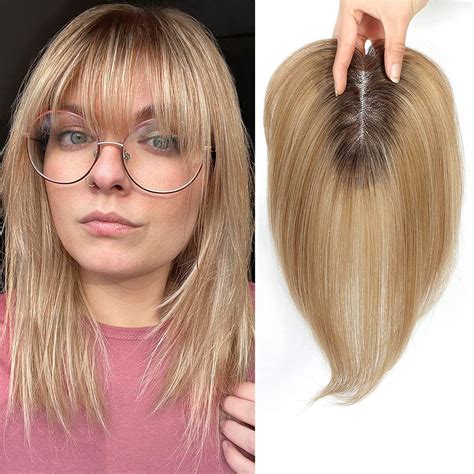Hair toppers with bangs are a great way to add volume, length, and coverage to your natural hair. They are also a versatile option that can be styled in a variety of ways to complement your face shape and personal style.

If you are considering getting a hair topper with bangs, there are a few things you should keep in mind. First, you need to determine what type of hair topper is right for you. There are seven main types of hair toppers, each with its own unique set of benefits and drawbacks.
Second, you need to choose the right size and color for your hair topper. The size of the hair topper should be based on the amount of coverage you need. The color of the hair topper should match your natural hair color as closely as possible.
Finally, you need to learn how to care for your hair topper. Hair toppers require special care to keep them looking their best. With proper care, a hair topper can last for several months.
There are seven main types of hair toppers with bangs:
- Clip-in hair toppers: Clip-in hair toppers are the most popular type of hair topper because they are easy to apply and remove. They are also relatively affordable. However, clip-in hair toppers can be bulky and uncomfortable to wear for long periods of time.
- Lace front hair toppers: Lace front hair toppers are made with a lace base that is attached to the scalp. This creates a natural-looking hairline. Lace front hair toppers are more expensive than clip-in hair toppers, but they are also more comfortable to wear.
- Monofilament hair toppers: Monofilament hair toppers are made with a thin, transparent material that is attached to the scalp. This creates a very natural-looking appearance. Monofilament hair toppers are more expensive than lace front hair toppers, but they are also more durable.
- Human hair toppers: Human hair toppers are made with real human hair. This gives them a very natural look and feel. Human hair toppers are more expensive than synthetic hair toppers, but they are also more durable.
- Synthetic hair toppers: Synthetic hair toppers are made with artificial fibers. They are less expensive than human hair toppers, but they are also less durable. Synthetic hair toppers can also be more difficult to style.
- Bangs toppers: Bangs toppers are a type of hair topper that is specifically designed to add bangs to your natural hair. Bangs toppers are a great way to change up your look without having to cut your own hair.
- Heat-resistant hair toppers: Heat-resistant hair toppers are made with fibers that can withstand heat styling. This allows you to style your hair topper with a blow dryer, flat iron, or curling iron.
Hair toppers with bangs can be customized to fit a variety of hair types. The following are the 10 most common hair types:
- Type 1 hair: Type 1 hair is straight and fine. It is often difficult to style and hold a curl.
- Type 2 hair: Type 2 hair is wavy. It is more voluminous than type 1 hair and can be styled more easily.
- Type 3 hair: Type 3 hair is curly. It is the most voluminous of the three hair types and can be difficult to style.
- Type 4 hair: Type 4 hair is coily. It is the most difficult to style of the three hair types.
- Type 5 hair: Type 5 hair is a combination of two or more of the other hair types.
- Type 6 hair: Type 6 hair is damaged hair. It is often dry, brittle, and difficult to style.
- Type 7 hair: Type 7 hair is over-processed hair. It is often very damaged and difficult to style.
- Type 8 hair: Type 8 hair is ethnic hair. It is often thick, coarse, and curly.
- Type 9 hair: Type 9 hair is fine hair. It is often thin and lacks volume.
- Type 10 hair: Type 10 hair is thick hair. It is often voluminous and difficult to style.
When choosing a hair topper with bangs, there are a few things you should keep in mind:
- The type of hair topper: The type of hair topper you choose will depend on your budget, your hair type, and your desired level of comfort.
- The size of the hair topper: The size of the hair topper should be based on the amount of coverage you need.
- The color of the hair topper: The color of the hair topper should match your natural hair color as closely as possible.
- The style of the bangs: The style of the bangs should complement your face shape and personal style.
Hair toppers require special care to keep them looking their best. Here are a few tips for caring for your hair topper:
- Wash your hair topper regularly: Wash your hair topper every 2-3 weeks with a mild shampoo and conditioner.
- Detangle your hair topper before washing it: Detangle your hair topper with a wide-toothed comb before washing it to remove any knots or tangles.
- Use a heat protectant spray on your hair topper: Use a heat protectant spray on your hair topper before blow drying or flat ironing it.
- Store your hair topper properly: Store your hair topper in a cool, dry place when you are not wearing it.
Hair toppers with bangs offer a number of benefits, including:
- Increased volume and length: Hair toppers can add volume and length to your natural hair, giving you the appearance of fuller, thicker hair.
- Coverage for hair loss: Hair toppers can cover up hair loss, whether it is caused by thinning hair, alopecia, or other medical conditions
